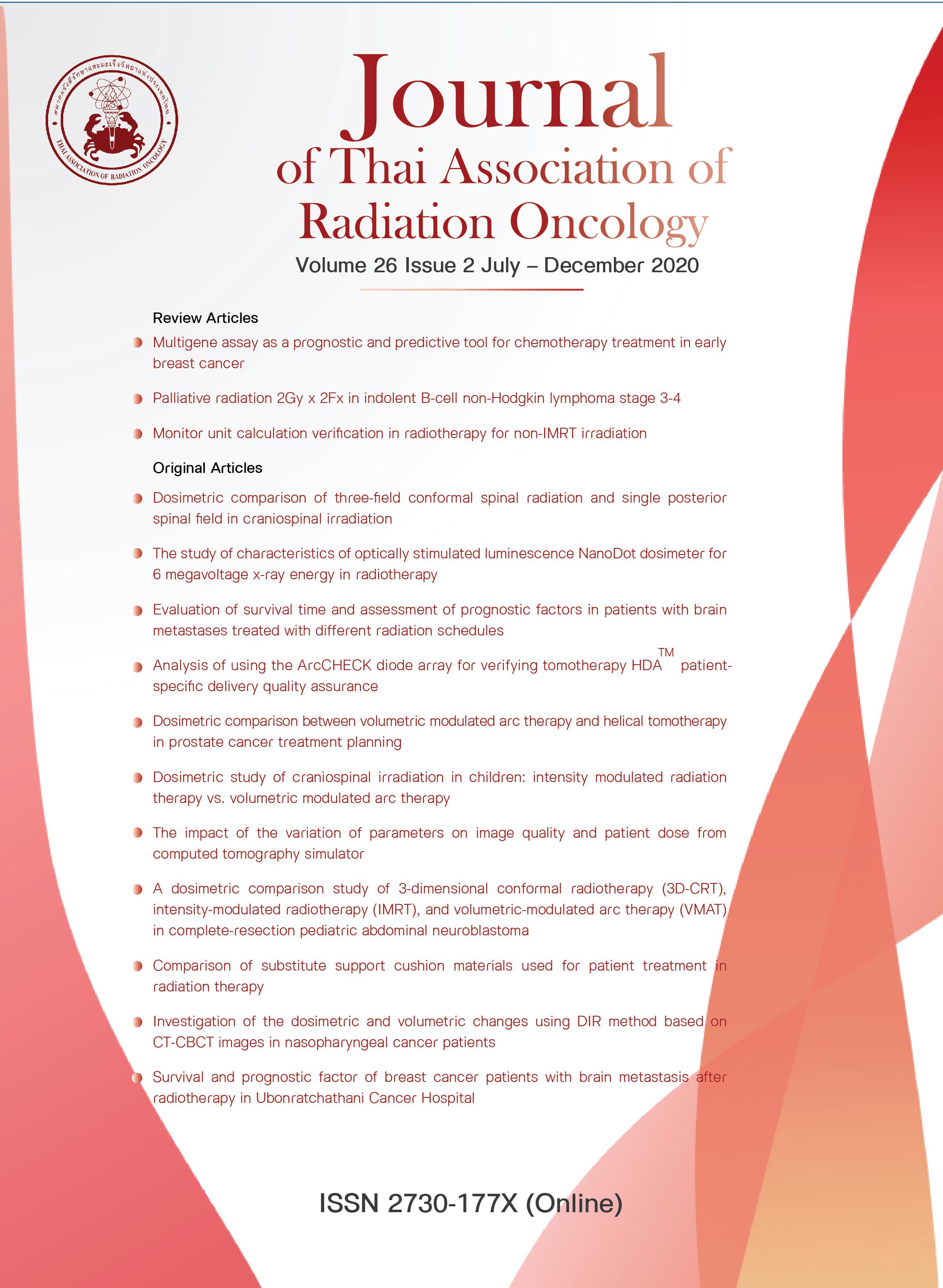Investigation of the dosimetric and volumetric changes using DIR method based on CT-CBCT images in nasopharynx cancer patients
Keywords:
Nasopharyngeal carcinoma, Deformable image registration, Cone-beam CT, Adaptive radiotherapyAbstract
Backgrounds
Dosimetric and volumetric variations of tumor and relevant organs in patients with nasopharyngeal carcinoma (NPC) were observed during volumetric modulated arc therapy (VMAT). A deformable image registration (DIR) algorithm can be used to track the delivered dose and to transform the delineated contour with different image modalities.
Objectives
The aim of this study was to assess the usability of DIR software based on computed tomography (CT) and cone-beam CT (CBCT) images as a tool for determining the volumetric changes and its dosimetric impact of tumor and organs at risk (OARs).
Materials and Methods
Fifteen NPC patients with a planning CT and weekly CBCT images were retrospectively studied. The DIR software, VelocityAl 4.0, was used to deform the initial plan dose and delineate contour onto the CBCT images for determining the variation. The cumulative dose and volume of PTV-high risk (PTV-HR) and OARs can be obtained from the dose volume histogram (DVH). In this study, the dice similarity coefficient (DSC) was also used to assess the volumetric changes.
Results
Compared with the initial plan, the doses delivered to PTV-HR were decreased while the mean doses to oral cavity and parotid glands were increased. The volumes of oral cavity and both parotid glands were decreased during the treatment course. The correlation between the DSC of both parotid glands and the treatment date was 0.743.
Conclusion
The DIR software based on CT-CBCT images can be used to investigate the variations of dose and volume during the treatment period for NPC patients in clinical practice.
References
Wang ZH, Yan C, Zhang ZY, Zhang CP, Hu HS, Kirwan J, et al. Radiation-induced volume changes in parotid and submandibular glands in patients with head and neck cancer: receiving postoperative radiotherapy: a longitudinal study. Laryngoscope. 2009; 119: 1966-1974.
Ajani AA, Qureshi MM, Kovalchuk N, Orlina L, Sakai O, Truong MT. A quantitative assessment of volumetric and anatomic changes of the parotid gland during intensity-modulated radiotherapy for head and neck cancer using serial computed tomography. Med Dosim. 2013; 38: 238-242.
Wang X, Lu J, Xiong X, Zhu G, Ying H, He S, et al. Anatomic and dosimetric changes during the treatment course of intensity-modulated radiotherapy for locally advanced nasopharyngeal carcinoma. Med Dosim. 2010; 35: 151-157.
Ahn PH, Chen CC, Ahn AI, Hong L, Scripes PA, Shen J, et al. Adaptive planning in intensity-modulated radiation therapy for head and neck cancers: single-institution experience and clinical implications. Int J Radiat Oncol Biol Phys. 2011; 80: 677-685.
Reali A, Anglesio AM, Mortellaro G, Allis S, Bartoncini S, Redda MGR, et al. Volumetric and positional changes of planning target volumes and organs at risk using computed tomography imaging during intensity-modulated radiation therapy for head-neck cancer: an “old” adaptive radiation therapy approach. Radiol med. 2014; 119: 714-720.
Zhang X, Li M, Cao J, Luo JW, Xu GZ, Gao L, et al. Dosimetric variations of target volumes and organs at risk in nasopharyngeal carcinoma intensity-modulated radiotherapy. Br J Radio. 2012; 85: e506-e513.
Sonke JJ, Aznar M, Rasch C. Adaptive radiotherapy for anatomical changes. Semin Radiat Oncol. 2019; 29: 249-257.
Hu YC, Tsai KW, Lee CC, Peng NJ, Chien JC, Tseng HH, et al. Which nasopharyngeal cancer patients need adaptive radiotherapy? BMC Cancer. 2018; 18:1234: 1-8.
Brock KK, Mutic S, McNutt TR, Li H, Kessler ML. Use of image registration and fusion algorithms and techniques in radiotherapy: Report of the AAPM Radiation Therapy Committee Task Group No.132. Med Phys. 2017; 44: e43-e76.
Oh S, Kim S. Deformable image registration in radiation therapy. Radiat Oncol J. 2017; 35: 101-111.
Jaffray DA. Image-guided radiotherapy: from current concept to future perspectives. Nat Rev Clin Oncol. 2012; 9: 688-699.
Nabavizadeh N, Elliott DA, Chen Y, Kusano AS, Mittin T, Thomas CR, et al. Image guided radiation therapy (IGRT) practice patterns and IGRT’s impact on workflow and treatment planning; results from a national survey of American Society for Radiation Oncology members. Int J Radiat Oncol Biol Phys. 2016; 94: 850-857.
Stankiewicz M, Li W, Rosewall T, Tadic T, Dickie C, Velec M. Patterns of practice of adaptive re-planning for anatomic variances during cone-beam CT guided radiotherapy. Tech Innov Patient Support Radiat Oncol. 2019; 12: 50-55.
Liu J, Lyman KM, Ding Z, Zhou L. Assessment of the therapeutic accuracy of cone beam computed tomography-guided nasopharyngeal carcinoma radiotherapy. Oncol Lett. 2019; 18: 1071-1080.
Ho KF, Marchant T, Moore C, Webster G, Rowbottom C, Penington H, et al. Monitoring dosimetric impact of weight loss with kilovoltage (KV) cone beam CT (CBCT) during parotid-sparing IMRT and concurrent chemotherapy. Int J Radiat Oncol Biol Phys. 2012; 82: e375-e382.
Wu RY, Liu AY, Williamson TD, Yang J, Wisdom PG, Zhu XR, et al. Quantifying the accuracy of deformable image registration for cone-beam computed tomography with a physical phantom. J Appl Clin Med Phys. 2019; 20: 92-100.
Velocity instructions for use. Varian Medical System; 2018.
Kumarasiri A, Siddiqui F, Liu C, Yechieli R, Shah M, Pradhan D, et al. Deformable image registration based automatic CT-to-CT contour propagation for head and neck adaptive radiotherapy in the routine clinical setting. Med Phys. 2014; 41: 121712-1-121712-10.
Mattiucci GC, Boldrini L, Chiloiro G, D’Agostino GR, Chiesa S, Rose FD, et al. Automatic delineation for replanning in nasopharynx radiotherapy: What is the agreement among experts to be considered as benchmark? Acta Oncol. 2013; 52: 1417-1422.
Tanooka M, Doi H, Ishida T, Katajima K, Wakayama T, Sakai T, et al. Usability of deformable image registration for adaptive radiotherapy in head and neck cancer and an automatic prediction of replanning. Int J Med Phys Clin Eng Radiat Oncol. 2017; 6: 10-20.
Downloads
Published
How to Cite
Issue
Section
License
บทความที่ได้รับการตีพิมพ์เป็นลิขสิทธิ์ของวารสารมะเร็งวิวัฒน์ ข้อความที่ปรากฏในบทความแต่ละเรื่องในวารสารวิชาการเล่มนี้เป็นความคิดเห็นส่วนตัวของผู้เขียนแต่ละท่านไม่เกี่ยวข้องกับ และบุคคลากรท่านอื่น ๆ ใน สมาคมฯ แต่อย่างใด ความรับผิดชอบองค์ประกอบทั้งหมดของบทความแต่ละเรื่องเป็นของผู้เขียนแต่ละท่าน หากมีความผิดพลาดใดๆ ผู้เขียนแต่ละท่านจะรับผิดชอบบทความของตนเองแต่ผู้เดียว




